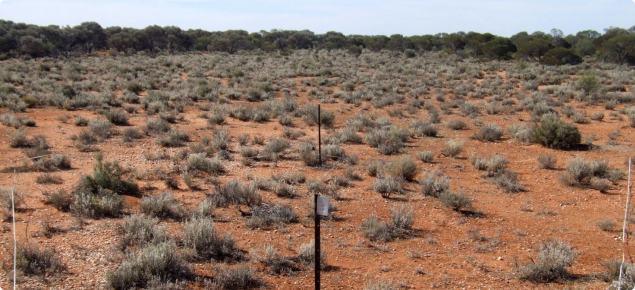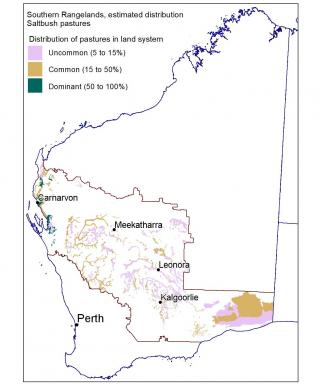Pastoral potential – high
Saltbush pastures have high pastoral value and are very valuable for pastoral use and have considerable durability in extended dry times when in good condition. They are more sensitive to grazing than bluebush pastures.
Suggested levels of use (per annum)
Table 1 provides a rough guide to the range of pastoral values for good condition pastures, which must be checked against conditions in each region and paddock. Carrying capacities for fair condition pastures might be 75% to 50% of good, and poor condition pastures less than 50% of good.
See Introduction to pastures in the southern rangelands of Western Australia for an explanation of how carrying capacities are estimated.
| Condition | Carrying capacity ha/DSE1 | Carrying capacity ha/CU2 (ha/AE3) |
|---|---|---|
| Good | 5.1–9.9 | 36–69 (43–83) |
1 DSE is based on the feed energy required to maintain a 45 kilogram liveweight Merino wether with zero weight change, no wool growth additional to that included in maintenance, and walking 7 km/day. 1 DSE has an energy requirement of approximately 8.7 MJ ME/day.
2 CU in the southern rangelands is based on a 400 kg steer at maintenance and equivalent to 7 DSE.
3 AE is based on the feed energy to maintain a 450 kg Bos taurus steer 2.25 years of age, walking 7 kilometers each day. 1 AE has an energy requirement of approximately 73 MJ ME/day and equivalent to 8.4 DSE.
Management
Grazing and spelling
These pastures are suitable for year-round use by all classes of livestock under conservative stocking rates. However, saltbushes and other desirable shrubs can be grazed out under continuous heavy use, leading to soil erosion. To manage grazing pressure, fencing large areas of saltbush pasture is recommended.
Pastures in fair or poor condition will require periodic spelling if condition is to be improved. Sheep on degraded saltbush pastures at high stocking rates had to be hand-fed in four of the ten years of the Boolathana trial (Holm 1994) to prevent losses, while the good condition saltbush pastures supported sheep without extra feeding, even in dry times.
Spelling during and immediately after the growing season until seedlings are well established and mature plants have set seed is recommended. Nutritious annual species grow prolifically after seasonal rains and stock can thrive even on degraded saltbush pastures for short periods.
Water supply
Saltbushes and bluebushes have high salt content, which makes it important to provide plenty of good quality water to maximise pasture utilisation and animal productivity.
Degradation and transitions
Summer rainfall can allow buffel and birdwood grasses to colonise these pastures. After the initial summer growth flush, protein levels fall and animals will graze remnant shrubs heavily in an effort to maintain protein intake. Established perennial buffel or birdwood grasses hasten the colonisation process. Buffel grass colonisation increases the risk of fire and may irreversibly change the pasture type, particularly when sandy areas are stabilised by buffel.
Good condition saltbush pastures can tolerate some flooding depending on inundation levels. Submerged saltbush pastures rarely survive and require spelling after flooding to allow recovery. Overstocking in dry times can result in stock pad development which results in topsoil loss, exposing hardpan or saline subsoils. This transition can occur over several years or after one major flood event. The topsoil cannot be replaced. The critical level of plant cover appears to be >10% PFC, so maintaining cover well above this threshold is essential.
Soil erosion is usually associated with a decline in pasture condition.
Pasture condition
Survey data show saltbush pastures in the southern rangelands are predominantly in poor condition and some areas are in very poor condition.
Good
See Figure 1. These pastures are dominated by saltbush, and may also support a diverse range of palatable plants such as sage, green cassia, Wilcox bush, bluebushes, cotton bush and tall saltbush, with annual herbs and grasses growing between the shrubs in good seasons. Young saltbush plants are present. Occasional bardie bush, needlebush, wait-a-while, tomato bush and silver poverty bush may be present. Most shrubs are growing on a soil mound. Well-developed cryptogamic soil crusts are evident and there is little or no soil erosion.
The best indicator of range condition is the number of saltbushes and other desirable shrubs present. Mature silver saltbush plants are larger than bladder saltbush, so numbers per unit area will be lower for country in similar condition. Around eight mature silver saltbushes per 10 square metres indicates good pasture condition; whereas mature bladder saltbushes in good condition pasture may range up to 25 plants (8000 plants per hectare for silver saltbush, up to 25 000 plants for bladder saltbush).
Fair
See Figure 2. This is indicated by a reduced population of saltbushes and desirable shrubs. Cotton bush may increase as more favoured shrubs disappear. Fewer desirable plants may allow undesirable shrubs to proliferate if germination conditions are favourable. Cryptogamic soil crusts are present, but some breakdown of crusts may be evident. Occasional minor to moderate wind and water erosion may occur, with some disintegration of soil mounds under shrubs occurring.
Poor
See Figure 3. Saltbush pastures in poor condition have reduced total vegetation cover. There are very few or no desirable shrubs remaining and the range of perennial plants will be reduced. In some cases, the only palatable plants remaining will be annuals in good seasons. Degraded saltbush pastures may be invaded by unpalatable larger shrubs such as needlebush, bardie bush, wait-a-while, cassias and silver poverty bush.
Cryptogamic crusts are poorly developed, patchy or absent. Active moderate to severe erosion is likely. Soil mounds under shrubs are significantly reduced or absent.
Saltbush community pasture condition photographs
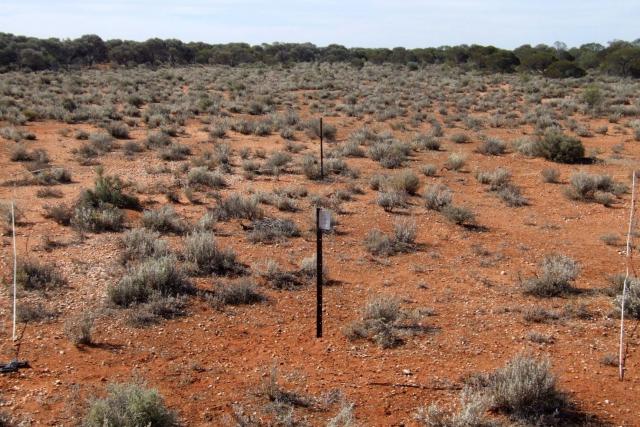
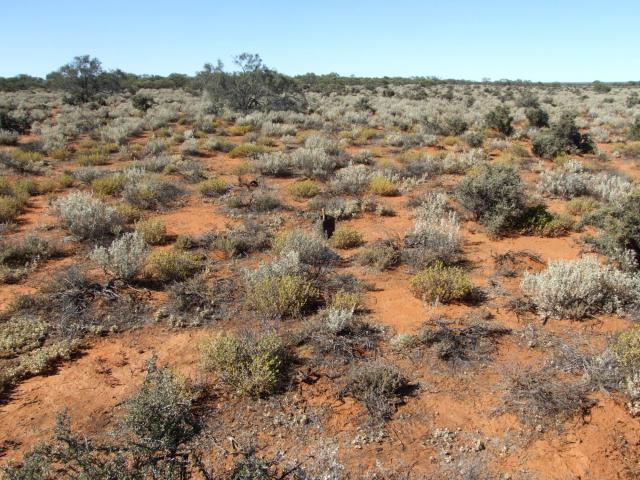
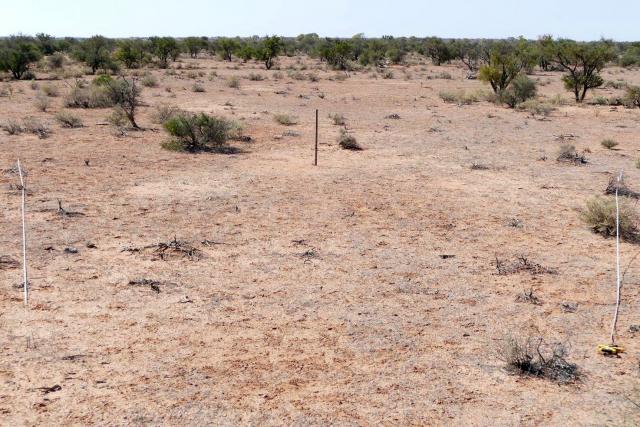
Vegetation structure and composition
Low saltbush shrubs are dominant when in good condition. Prominent low shrubs vary with geographical location and local factors, although silver saltbush and bladder saltbush are most common. Palatable medium shrubs including green cassia, mingah bush and tall saltbush are common. Desirable low shrubs other than saltbushes are diverse and may include bluebushes, mulla mullas, cotton bush and sage. Trees and tall shrubs are also varied, generally occurring as scattered individuals.
Undesirable shrubs include bardie bush, needlebush, cassias, poverty bushes and wait-a-while. These pastures support high quality annual plants in good seasons. Summer rain causes germination of annual herbs and some short-lived grasses. Introduced buffel and birdwood grasses have colonised some saltbush pastures; colonisation is usually grazing-induced and related to favourable seasons.
Occurrence
Saltbush pastures occur on flood plains of major river systems, ephemeral creeks and level plains surrounding salt lakes throughout the southern rangelands, covering about 2.33 million hectares (2.9% of the southern rangelands). These fertile pastures consist of duplex soils with sand or loam surfaces overlying saline clay. Cryptogamic crusts cover a major proportion of the soil surface.
Saltbush pastures occur on less saline soils than those supporting samphire pastures, but saltier than those supporting bluebush-dominated pastures. Soil depth varies with some soils more than a metre deep. Soils are generally susceptible to erosion. A distinctive pattern of shrub mounds is a feature of the level plains.
Associated plants
| Common name | Scientific name (links to FloraBase) | Desirability* |
|---|---|---|
| Ball leaf bluebush | D | |
| Bladder saltbush | D | |
| Cotton bush | D | |
| Currant bush | D | |
| Felty leaf bluebush | D | |
| Flat leaf bluebush | D | |
| Golden bluebush, George's bluebush | D | |
| Green cassia | D | |
| Mingah bush, bullock bush | D | |
| Ragged leaf fanflower | D | |
| Ruby saltbush | D | |
| Sage | D | |
| Scrambling saltbush | D | |
| Shy bluebush | D | |
| Silver saltbush | D | |
| Swamp saltbush | D | |
| Sweet samphire | D | |
| Tall saltbush | D | |
| Warty-leaf eremophila | D | |
| Woolly bindii | D | |
| Bardie bush | U | |
| Desert cassia | U | |
| Kidney saltbush | U | |
| Needlebush | U | |
| Rough saltbush | U | |
| Silver poverty bush | U | |
| Tomato bush | U | |
| Toothed saltbush | U | |
| Wait-a-while | U | |
| Curara | I | |
| Gascoyne mulla mulla | I | |
| Limestone wattle | I | |
| Mulga | I | |
| Old man saltbush | I | |
| Sago bush | I | |
| Cottony saltbush | I | |
| Waterbush | I | |
| Wilcox bush | I | |
| Woollybutt grass | I | |
| Buffel/birdwood grasses | Cenchrus spp. and hybrids | N |
| Speargrasses | Austrostipa spp. | N |
* D = desirable, U = undesirable, I = intermediate, N = no indicator value
Other resources
Holm, AMcR (1994) Boolathana Grazing Study Final Report 1983–1993, Western Australian Department of Agriculture report to the Australian Wool Research and Promotion Organisation, Perth.

